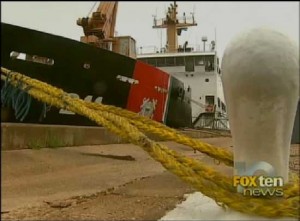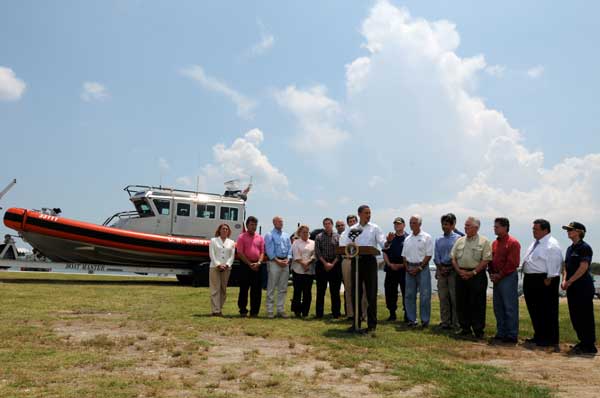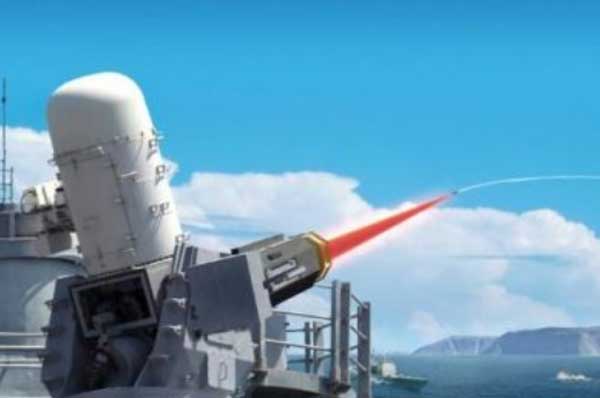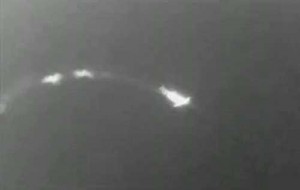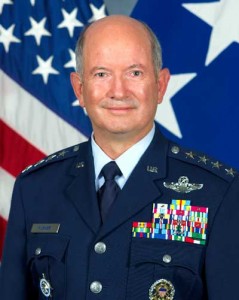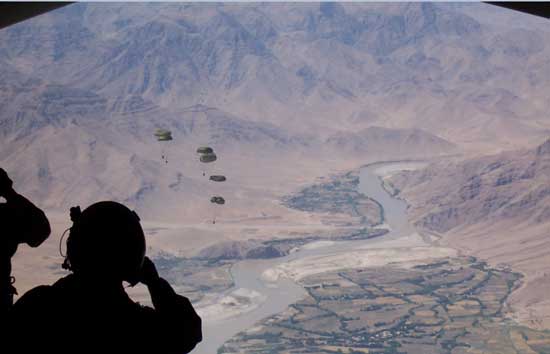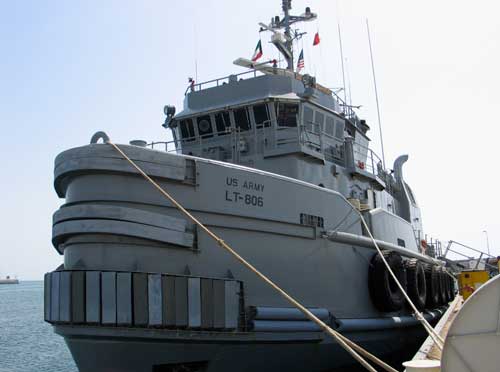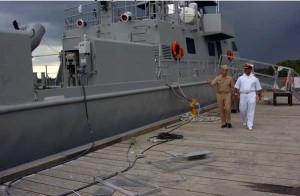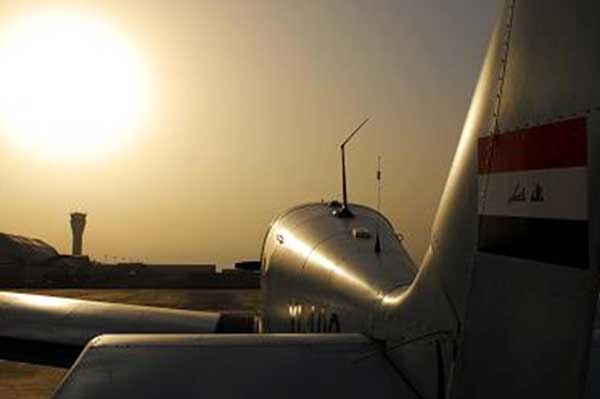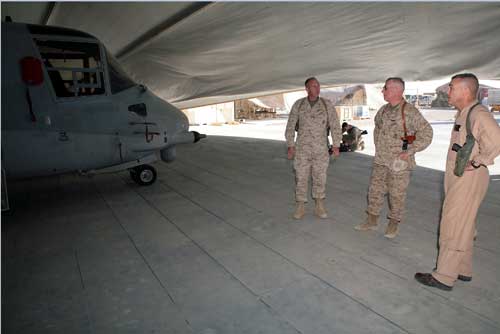Air Force Association White Paper Excerpts
As the support functions ramp up, the USAF has relied more on the KC-10s to provide for the tanker gap. And as the Administration moves forward to make a tanker decision, it is important to re-visit why tankers are so important to the US and coalition concepts of operations. As USTRANSCOM Commander General McNabb underscores, tankers and lift are key elements in supporting the operations in Afghanistan. Given the geography, air dropping and air support is central to operations, and this requires a tanker infrastructure.
In excerpts from the Air Force Association White Paper first published in September 2009, the Impact of the USAF tanker on US global concepts of operations is discussed. The excerpts are published with the approval of the Air Force Association.
***
[slidepress gallery=’re-visiting-the-usaf-tanker-impact-on-con-ops’]
This slide show pictures different operations of USAF tankers in the spring of 2010 [1].
All the photos are courtesy of the 380th Air Expeditionary Wing.
The US Air Force enhances airpower by providing air-refueling (A/R) aircraft at nearly every location around the world where our own services and coalition partners position forces. According to the 2008 AMC Air Mobility Master Plan (AMMP), “air refueling provides the flexible ‘air bridge’ concept, substantially enhancing our nation’s force projection capability. It functions as a ‘force multiplier’ by accelerating the deployment cycle and reducing dependency on forward staging bases and host-nation support.”
On a typical day, tankers provide refueling capability, cargo hauling support, aeromedical evacuation support, and various other taskings worldwide. For example, on a recent day the KC-10 flew 21 sorties offloading over 2 million pounds of fuel, supporting almost 130 receiver aircraft and augmenting the cargo and passenger system with its airlift capability. On the same day, KC-135’s flew 113 sorties directed by the Tanker Airlift Control Center (TACC) offloading nearly 3 million pounds of fuel to over 325 receivers.
Obviously, the impact of both the KC-10 and KC-135 is astonishing. The combined tanker fleets flew almost 135 sorties offloading over 5 million pounds of fuel, the equivalent of 16 Olympic-sized swimming pools, to 455 receivers on this particular day.
This joint combat capability cannot be duplicated by any alternative means. Without our tanker capability, these missions would not have occurred or would have had severely degraded consequences. Worldwide fighter movements would require multiple en route stops, and some would be almost impossible (e.g., Pacific Ocean transits). Theater combat sorties become short, limited-duration missions with very little loiter time to provide air superiority or close air support to troops in trouble on the ground.
In many cases, the mission would be impossible to execute without air refueling. Contingency mobility missions would require multiple en route stops at locations around the globe, overtaxing the already busy airfields. Air-refueling training sorties, necessary for the proficiency of both tanker and receiver aircrews, would stop, degrading the skills needed for operational missions. Finally, aeromedical evacuation missions scheduled on KC-135’s would have to quickly find alternate means of transportation for the injured with critical medical needs. The phenomenal combat survival rates we have seen in recent years have been, in part, due to the speed with which we have been able to get our injured service members returned to CONUS through the Aeromedical Evacuation (AE) System. The loss of an air-refueling capability would negatively impact casualty transit times and would add to the physiologic stress of our injured service members as they endured multiple aircraft refueling stops and transloads during their trip back to CONUS.
Impact of Grounded Tankers
With the loss of KC-135’s and KC-10’s across the globe, the many missions our tankers support would be significantly hindered. Considering that global air power incorporates the tanker into almost every battle and/or military movement plan, the consequences of the lost tanker capability need to be highlighted. There have been times when catastrophic tanker accidents temporarily put limitations on the use of our tankers and demonstrated the vulnerability of the tanker fleet. Three specific examples – including the 1989 Loring AFB fuel tank explosion, the 1993 Milwaukee Air National Guard KC-135 ground explosion, and the 1999 Geilenkirchen AB, Germany stabilizer trim malfunction crash – illustrate how quickly an unknown, inherent flaw in an aircraft structure could instantly affect the operations of all tankers worldwide.
The following are the major areas where the tankers are utilized every day. If lost, our global power, presence, and flexibility would be seriously degraded.
Deployment Air Refueling (CORONET)
In the early days of any conflict, one of the most critical functions of the tanker is delivering fighter units to the area of responsibility. Tankers accompany formations of fighters across the ocean or over long stretches of land, re-fueling the aircrafts multiple times along the way. Frequently, the tankers also carry cargo and personnel to support the fighter units at the forward location. The capability of air assets to fly nonstop to a theater may eliminate the need to obtain landing or overflight rights from foreign countries who may want to remain neutral in a given operation or conflict.
Without air-refueling capability, the task of delivering fighters to global positions would be severely eroded and in many cases impossible due to limited range of fighters and the distances needed to travel without suitable landing sites.
For example, consider the need to fly a set of fighters to Southwest Asia from the CONUS. Without being able to re-fuel planes mid-flight, multiple ground stops for aircraft and crew support would be necessary, re-routing the flight path to northern Canada, Iceland, and then hopping across the European continent. Short-notice diplomatic clearances complicate this flight plan as many of these clearances are difficult to obtain, require long lead times, and are time-limited.
In addition, during periods of force deployment or rotation, many bases’ need for ground refueling and turnaround are already full with a maximum-on-the ground (MOG). It is apparent that only a few, if any, long-range fighter movements would happen in this scenario. For example, the movement of 10 F-16C’s from Tulsa, Oklahoma to Iraq was conducted from 16-18 September 2008. This movement utilized two KC-10s and five KC-135s transiting through Moron AB, Spain as the only en route stop. Losing these tankers, the fighters (which unrefueled have only about two-hour legs) would have to hopscotch their way to the AOR, requiring at least an additional two days transit time.
A notional non-A/R fighter movement scenario begins with F-16’s at Langley AFB deploying to Kuwait. The first leg spans from Langley to a stop at Goose Bay, Canada. After a two-hour fuel and crew rest stop, the mission continues to Sondestrom, Greenland, requiring another two-hour refuel stop. The fighters move on to Keflavik AB, Iceland, where they stop and rest for 13 hours. The next day the fighters takeoff for RAF Lakenheath, England, where they regenerate their aircraft again and fly to Aviano AB, Italy for fuel and food. From there they proceed to Incirlik AB, Turkey for another full stop crew rest. The mission flies out of Incirlik with the last leg through Iraq to Kuwait. Total duration en route is more than three days.
This scenario does not take into account maintenance problems that usually accompany
multiple stops (seven) of multiple airplanes versus only two stops with refueling. In addition, the crew is required to fly over 12 hours more. This routing is also dramatically affected by weather (winds, seasons, etc.) and, as previously described, the capability of en route base support.
Finally, diplomatic clearances are needed for the countries of France, Greece, and Turkey. At present, such clearances are not difficult to obtain from friendly countries; however internal politics and difficulties in obtaining clearance approval from non-allied nations could delay the movement by several days.
Air Bridge Air Refueling
The ability to extend the legs of many cargo aircraft (C-5 and C-17) over long distances is a crucial function of our air mobility planning. For example, a fully loaded C-5 needs a large in-flight re-fuel over the Black Sea to make it from its departure in Spain to its cargo offload destination in Afghanistan. This prevents the otherwise necessary drop-in to an otherwise already overextended base such as Souda Bay, Greece or Incirlik AB, Turkey.
Additionally, legs from the CONUS to Europe or to the Far East for these large cargo haulers are greatly enhanced via en route air refueling (A/R) to avoid stops at already overused and full bases like RAF Mildenhall, England or Elmendorf AFB, Alaska. In this scenario, the Air Bridge is no longer possible requiring all cargo planes to stop en route for fuel and service as in the Deployment A/R scenario. Planes of all varieties will begin to saturate available ramp space along the flight route, taxing all ground support capabilities and causing many bases to refuse further arrivals due to inadequate capacity. As the scenario progresses, fewer and fewer bases become available and aircraft are no longer able to fly their planned missions simply because there are no longer any viable bases en route.
Our Operational Plans (OPLANs) are critically tied to tanker utilization, especially in the beginning stages. Without the use of tankers, the OPLANs (and our whole U.S. strategy in major wars) would not be executable. This would have dire consequences for the U.S. and the world. Instead of a rapid response to influence an opponent’s calculus, we would be forced toward a timeline that allows others to solidify their positions. With delay, the costs in time, treasure and lives escalate.
Global Strike Air Refueling
Fundamental to our nation’s military credibility is the ability to strike anywhere on the globe. With the loss of the tanker fleet, we lose the possibility of rapidly delivering our strategic bombing force to any destination. As with the previous situations, our strategic strike aircraft would have to hop-scotch their way to targets or sacrifice days to forward deploy to perimeter locations. Air refueling provides strike platforms the ability to reach any target globally without relying on intermediate basing locations or international diplomatic support. Our fighters would be unable to swiftly and directly strike targets in distant locations and safely return to non-hostile areas, especially for missions originating and terminating in the U.S.
Without tanker support, global strike assets would require time to deploy, diplomatic clearance for overflight, and basing. In addition, they would need forward maintenance and operational support as these plans might call for action with little or no warning.
The premise of global strike is a rapid response in a crisis situation. Without the tanker fleet, a response, if possible, would not be rapid. Decision-makers do not have the luxury of waiting to initiate a military movement. As with the example of fighter aircraft, multiple stops also elevate the risk of maintenance problems, which would require additional spare aircraft to be placed at bases in advance. However, this forward-deployment strategy takes extensive planning and immediate action is necessary because crises may occur at any time.
Let’s take a look at a B-2 attempting to move to the forward theater area without tanker assistance. With stop times and re-fueling, the non-A/R B-2 would arrive at the Forward Operating Base (FOB) at the earliest on Day 3. The Strike missions, however, would not be able to be executed until at least Day 4. This must be tempered, of course, with the staging of multiple aircrews, maintenance support, and the possibility of broken airplanes at en route locations. Once at the FOB, the B-2 must accomplish stage operations from there to the FOA until the theater combat operation is complete. With refueling, the B-2 is able to put bombs on target in less than 1 day and return to its home base after a day and a half. Plainly, the strategic expediency of the B-2, one of its core functions, is lost without tanker support.
Theater Support to Combat Air Forces (CAF)
Tankers play an essential role in the employment of combat aircraft within the theater AOR. This tanker support is essential not only to the U.S. Air Force aircraft, but also to those of the U.S. Navy and coalition partners. Intra-theater air refueling enables combat and combat support aircraft to increase their range, endurance, persistence, and flexibility. In-flight refueling allows them to carry a larger payload on initial takeoff by decreasing the amount of initial fuel required, thereby multiplying their combat force and combat efficiency. This capability is essential to carrier-based aircraft. Theater-based air-refueling assets also enhance the security of combat and combat-support air assets by allowing them to be based beyond the range of adversary threats.
Air Superiority with A/R vs Without A/R
Day-to-day operations in a combat area provide an outstanding example of the critical nature of refueling support. Tankers are a major influence within a typical AOR.
For example, the depictions in the accompanying figure show fighters flying Combat Air Patrol (CAP) and Close Air Support (CAS) in the AOR with and without A/R capability. In the CAP scenario, 12 F-22s are required to fly 24 A/R sorties (in a 24-hour period) with four hours of loiter time, then return back to FOB. Each loiter block provides the flexibility to reach out within a 500 NM threat zone and accomplish its mission. Without A/R capability, the U.S. must field 96 F-22s to fly 192 sorties (and must include quick turn arounds at the FOB) with loiter time shrinking down to 30 minutes on station. This requirement almost negates the F-22s effectiveness against enemy aircraft. The F-22 could possibly accomplish a very limited counterattack capability in the 30 minutes of loiter time (equating to slightly less than 240NM of threat zone range). However, after this time, it must tag-team with its replacement F-22 entering into the loiter area to accomplish sustained presence or military capability.
In the CAS scenario, 48 F-35s are required to fly 88 A/R sorties allowing two 45-minute loiters (within orbit area) and/or strike time (kill box area) with an A/R in between. Take away the A/R, and the U.S. will need to field 56 F-35s to maintain the required 88 sorties. This will only enable the F-35 to achieve 5 minutes of loiter time and not enough time to proceed to the kill area and accomplish its objectives. The F-35 will not be able to accomplish its mission of reaching the kill box and successfully return to base. Thus, in either case, without A/R, the mission will fail to accomplish its objectives. The additional force requires additional aircrew, ground personnel, basing infrastructure, and funding to support.
Theater Support to Mobility Air Forces (MAF)
Air refueling within the theater area of responsibility greatly extends the C-17 and C-5 ranges, giving these mobility assets much greater flexibility, capability, and range to deliver their needed cargo. By providing in-flight fuel, these giant cargo haulers no longer need to stop at mid-range locations. Depending on the needs of the Combatant Commander, these assets can adjust their destination or divert locations, accelerating the delivery of time-critical people and cargo. Mid-mission stops for fueling require three to four hours apiece. Each en route air refueling accelerates delivery by that same amount.
Without the tanker fleet, there needs to be more airlifters in the system to accomplish the same velocity and capacity of cargo delivery. With the burgeoning global air traffic, the increases are not easy to accommodate in the increasingly crowded international airspace.
KC-135’s play an important role in the aeromedical evacuation (AE) mission across the globe. In previous conflicts, dedicated aircraft provided aeromedical evacuation. The trip from the combat zone was a time consuming series of hops and stops resulting in repeated pressurization cycles, which were difficult for critical patients to endure. In contrast, current operations have abandoned dedicated aircraft in favor of rapidly transforming any airlifter or tanker into an AE platform. The range and receiver capabilities of these platforms make a direct delivery to the CONUS from the combat front possible. This direct delivery not only speeds care, but it also minimizes the footprint of the medical force required to deploy forward.
The aeromedical evacuation mission has shown an extensive improvement not only in patient transport time from the theater to CONUS, but how integrated the aeromedical evacuation has become within the mobility airlift system…. Today, with the increased medical capability aboard AE aircraft (Critical Care Air Transport Teams), the improvement in AE support equipment, and the increased patient turnover capability resulting from both regularly scheduled and In-System-Select designated AE aircraft. All of these factors work well together due to the availability to refuel MAF in-flight. Today, AMC-wide crews are trained in the aeromedical evacuation mission, as opposed to the limited aircraft and aircrews devoted to the mission in the past. We now have greater flexibility and ability to accomplish the mission resulting in more lives saved.
The tanker is an integral piece in this lifesaving system in its own right, complementing the C-17s and C-130s, sometimes comprising up to 30 percent or more of the aircraft dedicated to total AE airframe utilization. The increased flexibility tankers provide MAF aircraft, greatly increases our nation’s ability to provide timely, lifesaving aeromedical evacuation.
Strategic Nuclear Mission
The object of the strategic nuclear mission is to deter adversaries who have the ability to use weapons of mass destruction against us and to respond as necessary to their aggression. The tanker’s role is to refuel the bombers that are tasked against strategic targets to fulfill this mission. This mission, as part of our nuclear triad, has a very important role in our nation’s defense posture and is the original reason for developing A/R capability. Without tankers, this mission would be so severely degraded that our nuclear deterrence posture would not be as credible. The strategic aircraft flying these nuclear missions are heavily dependent on tanker support to accomplish their objectives. Work-arounds are basically non-existent and extensive re-planning with no tanker support may only accomplish limited objectives. We would reduce our deterrent and our strike capability.
Homeland Defense
Our nation demands the capability to defend itself and support government and civilian agencies in the event of a national emergency or disaster. This mission requires the ability to enforce our air sovereignty with airborne radar and interceptors and the ability to rapidly deliver cargo and passengers to and from the troubled locations. Tankers refuel air defense aircraft, thereby extending their on-station times and allowing larger cargo loads for CONUS-operating airlift aircraft. These are regional CONUS support missions with some tankers in a supporting role and additional tankers on alpha alert in preparation for a quick-response launch for the air defense of the United States.
Without tankers, homeland defense missions will be severely degraded as fighter and Command, Control, Intelligence, Surveillance & Reconnaissance (C2ISR) aircraft will no longer be afforded extended loiter time in their respective orbit areas. For example, 1 November 2008 was a typical day in the homeland defense mission. There were 21 air sovereignty fighters flying combat air patrol, 10 tankers refueling those fighters, and one tanker on alert ready to launch in an emergency. In an increased security situation, the lack of in-flight refueling resources will cripple the very critical homeland defense mission as fighter and C2ISR aircraft have to continuously land and refuel their aircraft leaving large vulnerabilities in the assigned areas.
———————————-
Footnotes
[1] Slideshow’s captions:
- In the first photo, a maintenance Airman from the 380th Expeditionary Aircraft Maintenance Squadron’s Extender aircraft maintenance unit provides direction to the flight crew of the KC-10 Extender from the 908th Expeditionary Air Refueling Squadron during flightline operations for the 380th Air Expeditionary Wing at a non-disclosed base in Southwest Asia June 7, 2010.
- In the second photo, a KC-135R Stratotanker deployed from Grand Forks Air Force Base, N.D., and a KC-10 Extender deployed from Travis AFB, Calif., are seen on the flightline operations area for the 380th Air Expeditionary Wing at a non-disclosed base in Southwest Asia on June 2. Both airframes support deployed air refueling efforts through the 908th Expeditionary Air Refueling Squadron. The 908th EARS, as part of the 380th Air Expeditionary Wing, supports operations Iraqi Freedom, Enduring Freedom, and the Combined Joint Task Force-Horn of Africa. The 908th EARS is a sub-unit of the 380th Air Expeditionary Wing.
- In the third photo, a flight crew from the 908th Expeditionary Air Refueling Squadron guides a KC-10 Extender, also from the 908th EARS, to a parking area at a non-disclosed base in Southwest Asia on June 2. According to statistics from Yancy Mailes, 380th AEW historian, KC-10’s assigned to the 908th EARS and the Airmen who support and fly them flew more than 230 missions off-loading nearly 35 million pounds of fuel to more than 2,100 aircraft from January through April 2010.
- In the fourth photo, a KC-10 Extender from the 908th Expeditionary Air Refueling Squadron is silouetted as the sun sets during operations for the 380th Air Expeditionary Wing on the flightline May 6, at a non-disclosed base in Southwest Asia.
- In the fifth photo, a KC-10 Extender from the 908th Expeditionary Air Refueling Squadron takes off for an air refueling mission from a non-disclosed base in Southwest Asia in the U.S. Central Command area of responsibility during operations for the 380th Air Expeditionary Wing on April 27. For the first three months of 2010, KC-10’s and the Airmen who support and maintain them supported more than 1,000 sorties refueling more than 6,600 aircraft and off-loading more than 108 million pounds of fuel to those aircraft supoorting combat operations.
- In the sixth photo, a U.S. Navy F-18 is refueled by a KC-10 Extender from the 908th Expeditionary Air Refueling Squadron during an air refueling mission in the U.S. Central Command area of responsibility on April 24.
- In the final photo, a U.S. Air Force F-16 Fighting Falcon is about to be refueled by a KC-10 Extender from the 908th Expeditionary Air Refueling Squadron during an air refueling mission in the U.S. Central Command area of responsibility, April 24.
———–
*** Posted on July 15th, 2010
